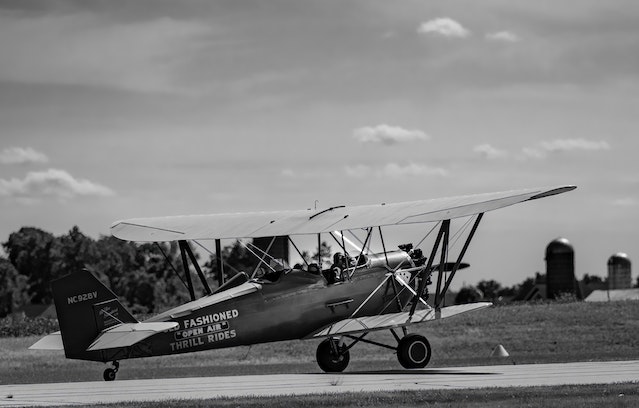
What happened to biplanes and triplanes? They produce too much drag, which means they can’t fly fast enough and they use a lot more fuel.
The first planes built were biplanes. The first heavier-than-air plane was a triplane. Sir George Cayley built a glider with three wings in 1848. He managed to convince a local boy to ride it and it flew successfully. The Wright Flyer, the first heavier-than-air powered plane in 1903 was a biplane. Triplanes and biplanes were used through World War 1, but they had all but disappeared by the 1930s. These days, they are only used for aerobatics. There are three main reasons why it was natural to make biplanes and triplanes in the early days of flight.
The first reason is the strength of the wing. Any plane that flies has to be supported by its wings. If the wings are not strong enough, they could snap and break off. Biplanes allow the weight of the plane to be spread across two wings and triplanes across three wings. The wings were fastened to each other with cables, supporting and strengthening each other. This reduced the weight load on any one wing and meant the wings could be made of a lighter material. Reducing the weight of planes was an obvious goal and the more wings, the thinner each wing could be.
The second reason is the stall speed. The extra wings meant that the planes were lighter and have a lower wing load. These factors meant that biplanes and triplanes have a very low stall speed. A plane stalls when there is not enough airflow over the wing and the plane can’t generate lift. This happens at a different speed for every plane, but the lower the stall speed, the slower the plane can be flown. When planes were in their infancy, engines had very little power. The engine on the Wright Flyer was a 12-horsepower gasoline engine, which pushed the plane to 48 km/h. A monoplane would have stalled at these speeds unless it had very long wings, which would have been hard to engineer in the early days of the 20th century.
The third reason is the maneuverability. Biplanes spread the load of the plane over several wings, so each wing can be shorter. Shorter wings give a plane a faster roll rate than a longer wing. This meant that biplanes became commonly used as fighter planes during World War 1, which kept them in service probably for longer than they should have been. It was based on a mistaken assumption. The fighter pilots of World War 1 lived for the dog fight and pilots became famous for how many enemy planes they downed. However, most kills in World War 1 were made by dropping down on unsuspecting planes from above and shooting them. Even the Red Baron admitted to this tactic. Fighter pilots insisted on planes that were highly maneuverable for the dog fights when, in actual fact, they would have been better served with faster monoplanes. This misunderstanding kept the biplane in service.
So, what happened to biplanes and triplanes. After World War 1, plane engines grew more powerful and planes were able to fly much faster. Biplane and triplane wings are strong because they split the load, but they produce an enormous amount of drag. All of the wires, the struts, and the extra wing surface area, produced so much drag that biplanes and triplanes could never fly fast enough. The drag also made them very uneconomical because they needed a lot more fuel. This meant they couldn’t fly as fast or as far as a monoplane.
Also, by the 1930s, it was possible to make planes that had very strong wings using modern, lighter materials. Aluminium had been discovered in 1825, but it only started to mass produced in World War 1. Titanium was available for planes by the 1930s as well. It wouldn’t be perfected until the 1950s, but the combination of these stronger and lighter metals meant that it wasn’t necessary to spread the weight of a plane over two or three wings.
Monoplanes are faster, more economical, can fly further, and are easier to use than biplanes. There is no longer a need for biplanes or triplanes any more, and they would have been phased out even earlier if people had actually looked at the way planes were shot down in the war and not listened to the pilots. These days, the only place biplanes are still used is on the aerobatics circuit. The low stall speed and fast roll rate make these planes ideal for aerobatic shows. And this is what I learned today.
Photo by Chris F: https://www.pexels.com/photo/biplane-in-black-and-white-9272112/
Sources
https://en.wikipedia.org/wiki/Triplane
https://en.wikipedia.org/wiki/History_of_aviation
https://en.wikipedia.org/wiki/Biplane
https://www.quora.com/What-are-the-pros-and-cons-of-biplane-vs-triplane
https://aviation.stackexchange.com/questions/12143/why-are-there-no-longer-any-biplanes
